In our first review of the Intel Xeon E3-1200 V6 series, we have the Intel Xeon E3-1240 V6. The CPU has four cores and eight threads based on Intel’s Kaby Lake architecture. With the Intel Xeon E3 V6 chips we also get 8MB L3 cache. The other key stats are that this CPU has a base frequency of 3.7GHz and a max Turbo frequency of 4.1GHz. TDP is listed at 72W however it does sip power.
In terms of where the Intel Xeon E3-1240 V6 sits in the overall stack here is a look at all of the announced SKUs:

This chart was from our initial Xeon E3-1200 V6 value comparison piece. There, we simply took clock speeds * (cores + modifier for HT threads). As a result, we saw the E3-1240 V6’s lower purchase price at $272 MSRP and relatively higher clock speeds as a significant value. Today, we have some real performance data to add. We will note that the Intel Xeon E3-1245 V6 offers comparable CPU performance but adds integrated graphics. If you want the integrated GPU, that is the version of this CPU to get. In fact, one may argue for $12 more it may be worth getting if you think there is a chance you will use the GPU features.
Test Configuration
For this setup, we used what we would expect to be a fairly typical server:
- CPU: Intel Xeon E3-1240 V6
- Motherboard: Supermicro X11SSH-F
- RAM: 2x 16GB ECC DDR4-2400 (Crucial)
- SSD: Intel DC S3710 400GB
- OS: Ubuntu 14.04.5 LTS (performance benchmarks), Ubuntu 16.04.2 LTS, VMware ESXi 6.5, Centos 7.3
We did want to take a moment and discuss some of the comparison data we are going to use. We do have the entire AMD Ryzen SKU stack to data along with the entire Xeon E3-1200 V6 range’s CPU core/ clock variants. We also have some legacy data points to give additional perspective.
The Ryzen comparison is tough. Although it supports ECC memory on the CPU, we still are not seeing enough software maturity to call it a stable server platform. In addition, there are great workstation platforms but no real server platforms at the time of this writing. If you want a server, you want E3-1200 V6. If you are building a workstation with an NVIDIA or AMD GPU, Ryzen is certainly a competitor.
We have the Intel Core i7-7700 and i7-7700K chips in the comparison as well. Although many vendors will say workstations absolutely require ECC memory, there are plenty of customers who will trade ECC memory for 25% more performance.
Intel Xeon E3-1240 V6 Benchmarks
For our testing, we are using Linux-Bench scripts which help us see cross platform “least common denominator” results. We are using gcc due to its ubiquity as a default compiler. One can see details of each benchmark here. We are likely going to update the Linux-Bench shortly with a few new tests as well as an even simpler to use/ faster revision, but for now, we are using the legacy version that now has over 100,000 test runs under its belt.
Python Linux 4.4.2 Kernel Compile Benchmark
This is one of the most requested benchmarks for STH over the past few years. The task was simple, we have a standard configuration file, the Linux 4.4.2 kernel from kernel.org, and make with every thread in the system. We are expressing results in terms of compiles per hour to make the results easier to read.
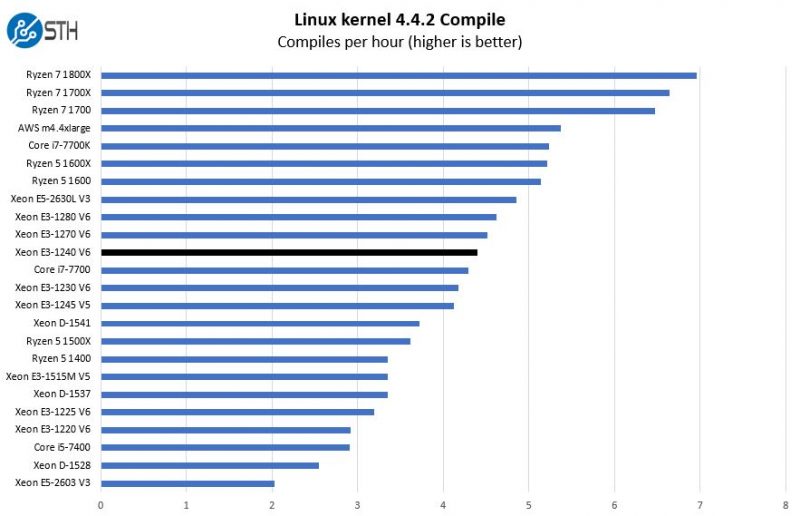
We have a comparison to the Intel Xeon E3-1245 V5 which had the same clock speeds as the E3-1240 V5. As you can see, there is a tangible benefit to using this CPU. That is why we are going to recommend V6 over V5 processors across the board as we get into this series.
c-ray 1.1 Performance
We have been using c-ray for our performance testing for years now. It is a ray tracing benchmark that is extremely popular to show differences in processors under multi-threaded workloads.
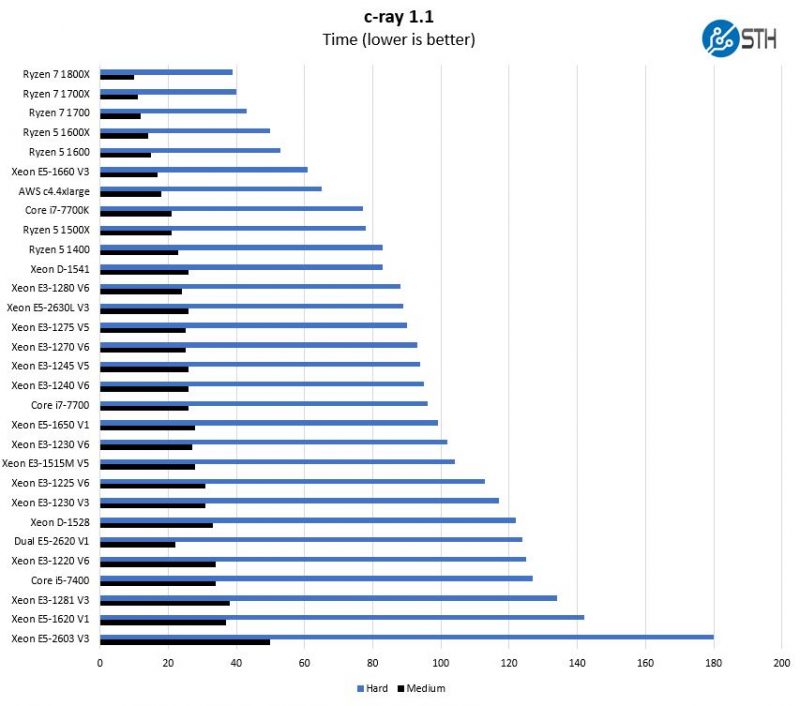
Here you can see that the E5-1240 V6 performs about in the middle of the SKU stack. All of the Intel LGA1151 chips perform about equal.
This is also a test where we historically have seen the AMD Ryzen perform very well. If you look at the four core / 8 thread Ryzen 5 chips you can see they are ahead of all but the Intel Core i7-7700K. There is a reason AMD hammered this type of workload (e.g. Cinebench R15) with the press.
7-zip Compression Performance
7-zip is a widely used compression/ decompression program that works cross platform. We started using the program during our early days with Windows testing. It is now part of Linux-Bench.
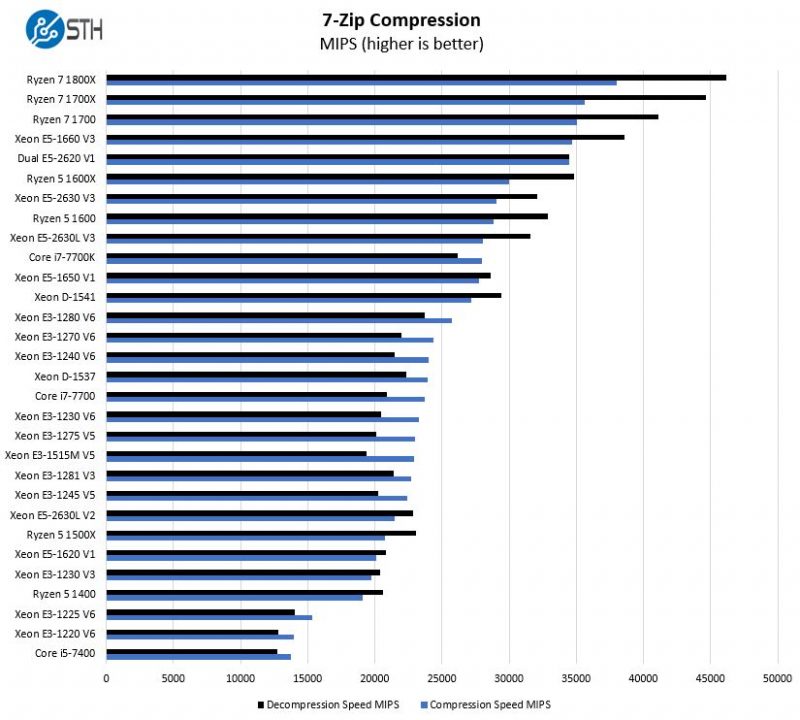
Almost dead-center in this chart is the E3-1240 V6. Here we see an improvement over the past generation Intel Xeon E3-1275 V5. Since we are now on our sixth generation, there is a pattern emerging where we see that the price point of a given level of performance decrements by one model stepping per generation.
NAMD Performance
NAMD is a molecular modeling benchmark developed by the Theoretical and Computational Biophysics Group in the Beckman Institute for Advanced Science and Technology at the University of Illinois at Urbana-Champaign. More information on the benchmark can be found here. We may replace this or augment with GROMACS in the next-generation Linux-Bench as that test is currently running through regressions.
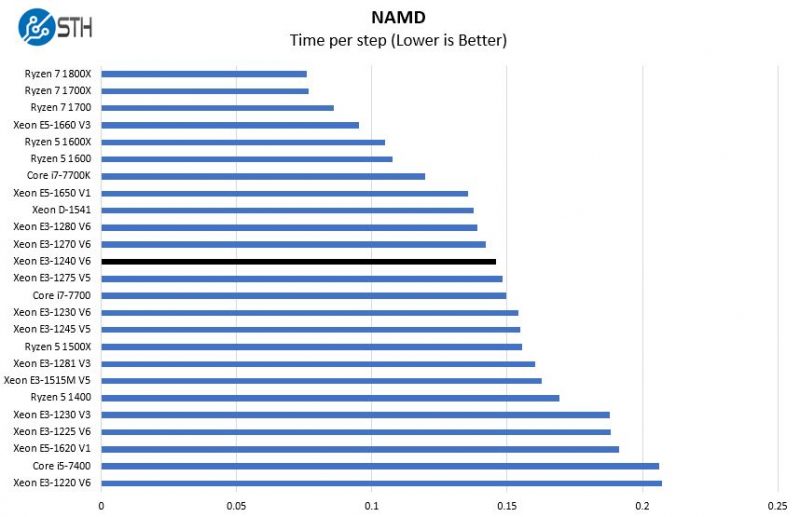
Looking at our NAMD results, we again see an interesting trend. The V6 Kaby Lake processors with their two-generation newer cores and high clock speeds are able to be competitive with the Broadwell-DE (Xeon D-1541) 8 core/ 16 thread parts.
Sysbench CPU test
Sysbench is another one of those widely used Linux benchmarks. We specifically are using the CPU test, not the OLTP test that we use for some storage testing.
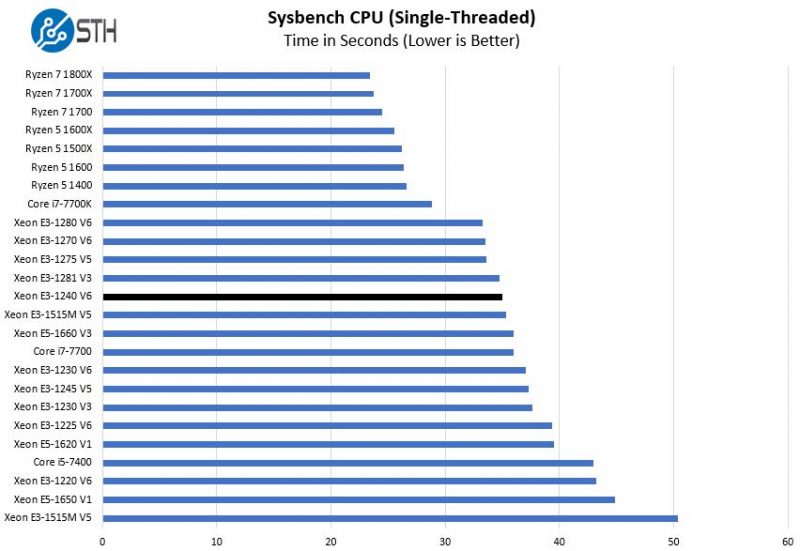
Sysbench’s CPU test performs extremely well on Ryzen. At the same time, we can see that the Intel Xeon E3-1240 V6 just about matches the top-end SKU from the V3 generation, the Intel Xeon E3-1281 V3. The “1” variant was a refresh CPU offering higher clock speeds.
The Intel Xeon E3-1281 V3 is a great comparison point because it offers the same 3.7GHz base and 4.1GHz turbo clocks as the E3-1240 V6. In the other benchmarks we have, we are seeing the three generation newer architecture pull away in multi-threaded tests. In this particular test they are in a virtual dead heat within a 1% test variation. Three generations later we see a $600 level of performance sold for less than half at well under $300.
OpenSSL Performance
OpenSSL is widely used to secure communications between servers. This is an important protocol in many server stacks. We first look at our sign tests:
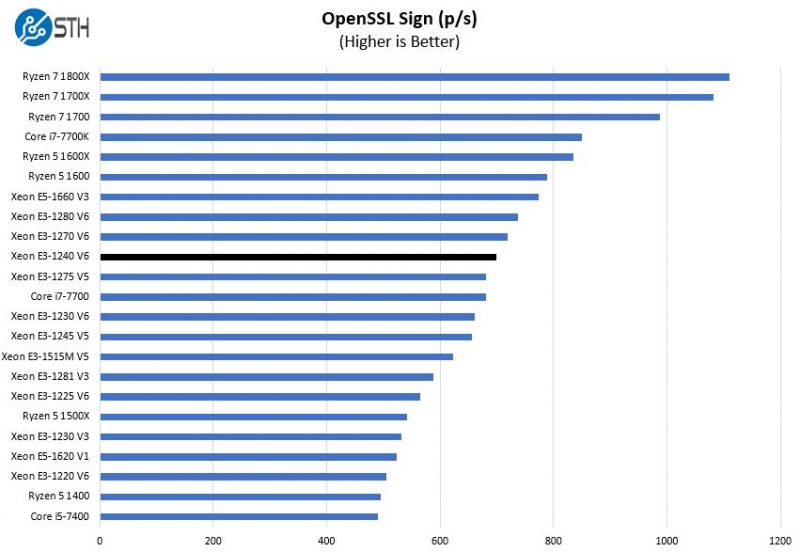
And our verify tests:
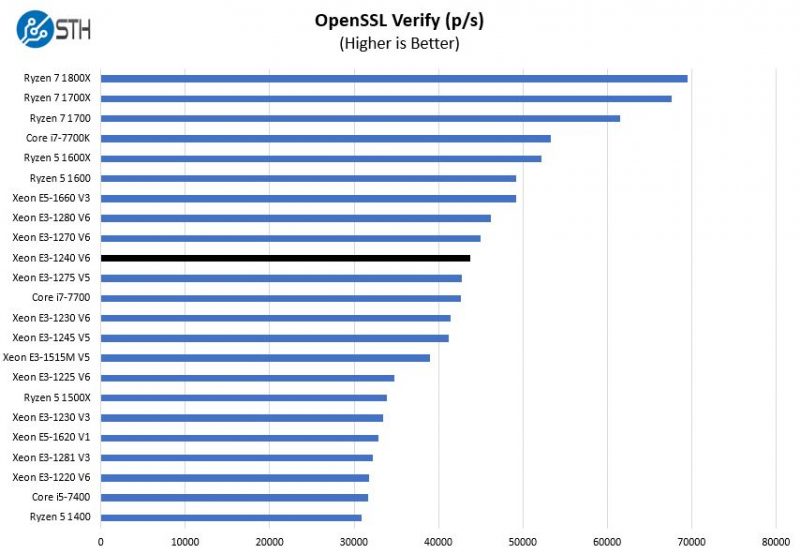
Here you can see that the there has been a huge improvement over older-generation chips. While the E3-1281 V3 with the same clocks is relegated to results near the bottom of our charts, the E3-1240 V6 is squarely in the middle.
UnixBench Dhrystone 2 and Whetstone Benchmarks
One of our longest running tests is the venerable UnixBench 5.1.3 Dhrystone 2 and Whetstone results. They are certainly aging, however, we constantly get requests for them, and many angry notes when we leave them out. UnixBench is widely used so it is a good comparison point.
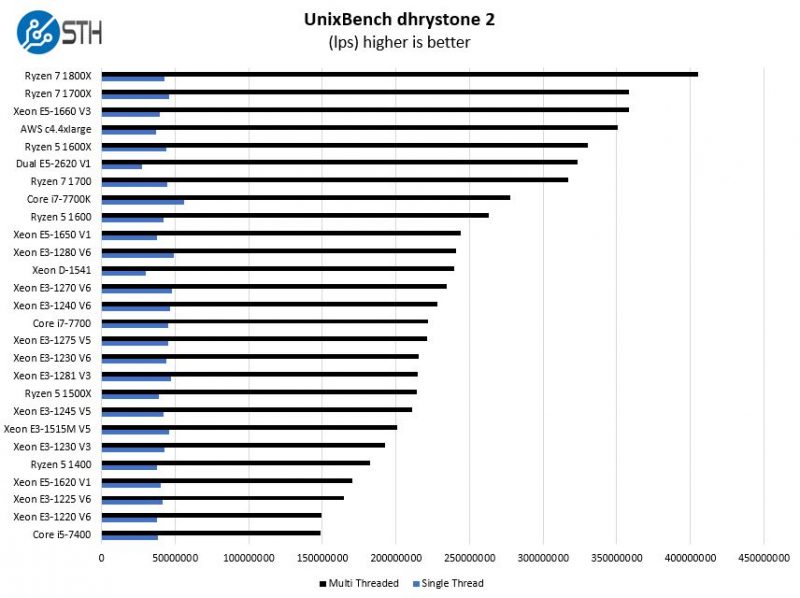
And the whetstone results.
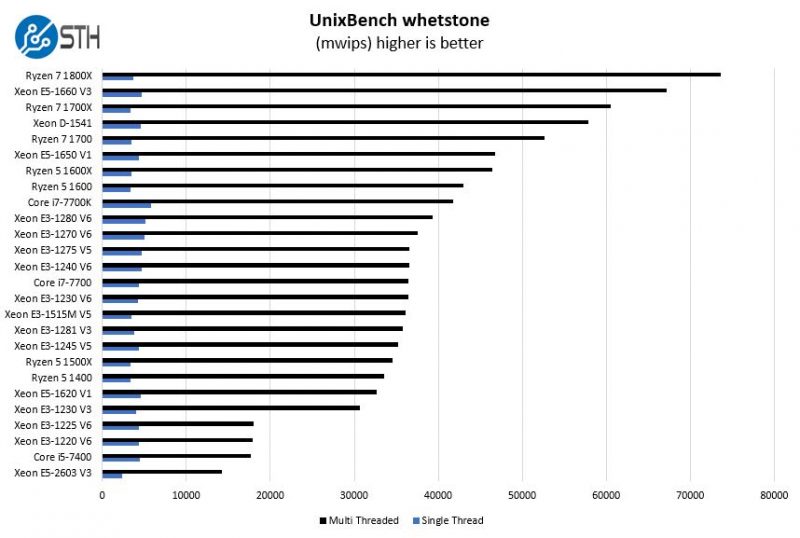
There are a few bits to notice here. Although the E3-1240 V6 is only four cores, the single threaded performance is much better than AMD despite running on 30% less power than the six and eight core Ryzen chips. The whetstone test also shows some impressive gains from Hyper-Threading.
Final Words
Our recommendation for a 4 core / 8 thread server chips after this exercise lies squarely with the Intel Xeon E3-1200 V6 series, like the Intel Xeon E3-1240 V6. Multiple vendors have mature server platforms for them. At this point, with the software maturity level for AMD’s SMT modules, the initial purchase price differential is inconsequential versus the platform stability level you get on mature Intel systems.
On the workstation side, it is more nuanced. For workstations, Intel has an ace up its sleeve, the integrated GPU on the E3-12×5 V6 CPUs. The GPU makes power consumption much lower than even adding a low-end PCIe ~25W GPU to a system.
If you want single threaded performance, getting the Intel Core i7-7700K is still where it is at. It is an absolute monster even without overclocking. You lose ECC memory but coincidentally gain a GPU.
If you want multi-threaded performance in a Linux workstation, and you do not mind dealing with occasional reboots, then the E3-1240 V6 becomes a much harder sell with alternatives available for $40 more that have 2x the cores/ threads.
Intel may argue that the Intel Xeon E3-1200 V6 line is meant for servers, but their own launch materials and SKUs target the workstation market, and partners market desktop systems with the Intel Xeon E3-1200 V6 line.

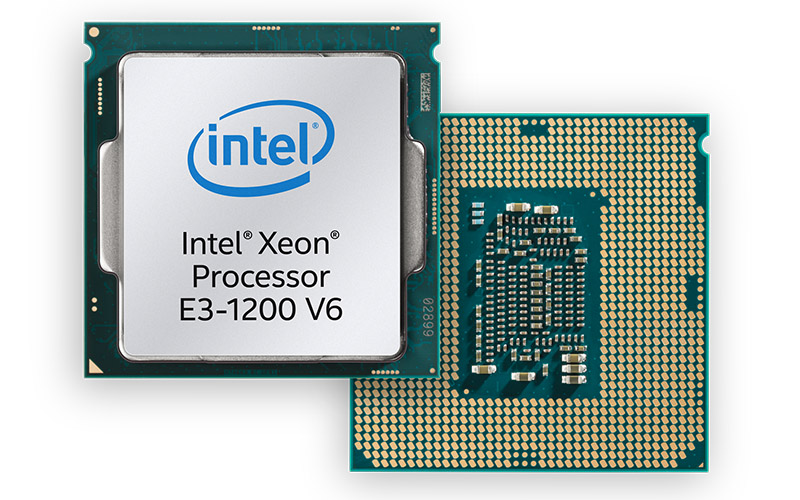



Hey Patrick, could you post a `cat /proc/cpuinfo` output?
I’d be interested in the features enabled for the E3 v6 Xeons.
Hi John. I will try to remember to do this next time I have access. Our testbed is now in our DemoEval service on a 3-week demo. (We have to pay for this work somehow.)
Also many users think ECC on WS is a basic setup. Any activity where the results of a simulation or calculations is critical for the security of people or thing’s need a ECC Memory. I think a engenier will not trade 25% increase performance with the life of hundred of people.
Oh man, those Ryzen numbers may be a cold shower for Intel. Let’s wait for proper ECC support and then purchasing E3 would be just a poor joke…
What were actual power numbers? Have a couple e3-1280v5 running ~54 watts.
@MrWu if you are doing simulation work where you need to have ECC support, you are going to get RDIMMs anyway.
@ MrWu: Statistically, your program is far far more likely to produce the wrong answer or fail due to bugs than neutron strikes. RAS matters when you have thousands of CPUs running workloads that run for days. Then, yes, ECC and RAS features start to show their effect, iff your program is so mature that it’s been virtually unchanged for years, and all serious bugs have been ironed out. Honestly, how many programmers understand floating point rounding errors and how to get around it, just to pick a basic source of program errors, and re you sure that regardless of input, your answer is always within a bound? Are you sure your code has no buffer overruns, or multithreading bugs? Are you sure your compiler is bug-free? RAS is a nice way for vendors to charge you a premium (heck, that’s IBM’s business model), and there are certain places where it makes sense. A workstation isn’t it, IMHO.